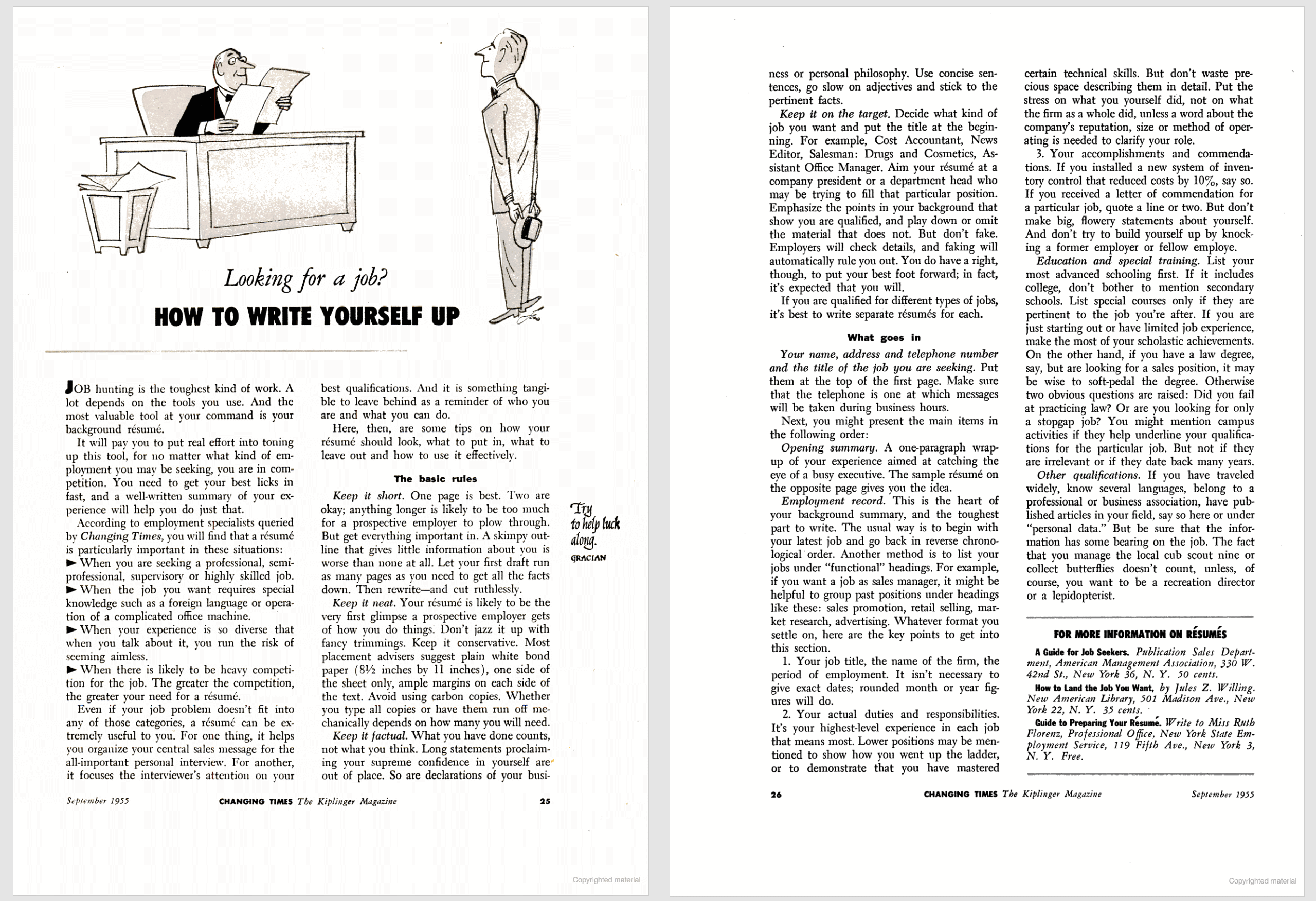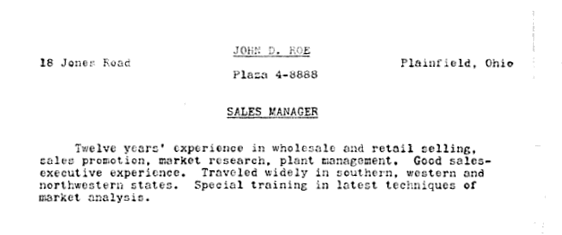While researching resume length recently, I wondered when today’s resume standards were established and how resume advice has changed over the years. I uncovered something surprising: An article from a 1955 issue of Kiplinger’s Changing Times that, a handful of statements aside, seems every bit as modern as something that might appear on a career blog today.
In other words, resume advice hasn’t changed a whole lot in 60-plus years.

That said, some of this resume advice has taken on new meaning in the 21st century. Below are a few resume tips straight from that article worth re-emphasizing 60-plus years later.
6 pieces of resume advice that stand the test of time
1) “Decide what kind of job you want and put the title at the beginning”
Changing Times suggested putting the job title you want at the top of the resume in order to “aim your resume at a company president or a department head who may be trying to fill that particular position.” While this might have been creative or novel resume advice in 1955, including the job title is downright critical going into 2019.
99% of Fortune 500 companies use applicant tracking systems (ATS) to collect resumes and identify top candidates. A recruiter or department head trying to fill that particular position is likely to search their ATS for the exact job title. They want to find someone who has done the job before.
That’s why “Job Title Match” is one of the most important checks in our resume match report here at Jobscan. It was a game changer then and it’s still a difference maker today. Ensure that the job title you’re shooting for is on your resume.
There were no applicant tracking systems in 1955. Changing Times reminds us that it’s not just about search algorithms. Getting the job title you’re after atop your resume also helps you pass the eye test.
2) “Get your best licks in fast”
Top-loading your resume with hard-hitting information was great advice then and it’s still key now.
While the resume objective statement is known to be old and outdated, I didn’t realize that resume summary statements were already catching on six decades ago. One of the ways Changing Times suggested top-loading a resume was to use a summary, or “a one-paragraph wrap-up of your experience aimed at catching the eye of a busy executive.”
Here’s their example:

A hallmark of a “modern” resume format, the summary is a great place to set the tone, slip in key skills, and effectively frame the rest of your experience.
3) “Be sure that the information has some bearing on the job”
Tailoring your resume to the specific job description might be the core tenant of resume writing advice today. It makes you a better candidate whether you’re focused on being recruiter-friendly or creating the best ATS resume possible.
Review each piece of information on your resume through the lens of, “Does this make me look like a better candidate for this job?” If it doesn’t, consider cutting it.
On the flip side, comb through the job description with a similar mindset. “Does my resume account for this job requirement?” If not, find a way to address it if applicable.
Jobscan automates this process by analyzing your resume against the job description. The resume match report identifies the top hard skills, soft skills, and resume keywords missing from your resume.
You can try it right here in the article:
4) “What you have done counts, not what you think”
This is great resume advice in general, but especially when it comes to including soft skills. You can’t just write, “I’m a leader” or “I’m hardworking” and expect them to believe you. It’s better to find ways to demonstrate these abilities on your resume.
One of the best ways to do this is through specific and tangible accomplishments, which is still discussed today as a hot new resume tip. However, Changing Times wrote, “If you installed a new system of inventory control that reduced costs by 10%, say so.”
5) “Use concise sentences… and stick to the pertinent facts”
Resume writer Adrienne Tom once wrote for Jobscan that decision makers “want straight facts, fast.”
“Eliminate wordiness and excess details and just deliver straight facts,” she wrote, advising job seekers to keep the reader’s attention with short sentences and bullet points. Learning how to shorten your sentences will make your resume a lean, mean, attention-getting machine.
6) “Job hunting is the toughest kind of work. A lot depends on the tools you use”
It’s grueling out there, but you don’t have to go about it alone. Jobscan was borne out of a job seeker’s frustration and is dedicated to creating the best tools for job seekers. These include our flagship resume optimization tool, LinkedIn Optimization, resources from the Learning Center and blog, and much more.
These tools are designed to shorten your job search and get you where you need to be. We hope you’ll explore the site, try the tools, and let us know if you have any questions.




















